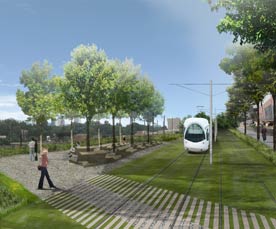Making the Case
The biggest step, perhaps, is making the case, and GCC spends a lot of its energy on that. In Antioch, Calif., GCC worked with the city and the city’s consultants to organize a public tour of the various potential sites within the planning process. From Pittsburg, they took people to see what “good developments” looked like from other parts of the region. From San Leandro, a city that was considering (and has since approved and developed) a downtown TOD project centered around a future bus rapid transit station and the San Leandro BART station, GCC organized a tour of affordable housing in Oakland. These outreach efforts, Hobson said, likely changed some hearts and minds.
In Antioch, for example, he says “We heard some things that bordered on the racist when it came to opposition to affordable housing. ‘I don’t want to live near those people,’ and that type of thing.” By the end of the tour, while those in opposition were not necessarily advocates, it was clear to all that affordable housing could be done well. GCC’s involvement helped usher a village plan that creates a land use and regulatory framework that allows up to 2,500 residential units, with at least 15 percent of that being affordable to
moderate-, low-, or very low-income households in line with state law, and 2.5 million square feet of commercial space. The affordability requirement would be met on a project-by-project basis, said Victor Carniglia, Antioch’s director of economic development. The city itself does not have an inclusionary housing requirement, but “it should not be hard to meet given the densities allowed and the relatively high median income levels in the census tract where the area is located,” he said. Getting approval for the plan, GCC’s Hobson said, could have been a “messy process” had it not been completely vetted by the community first.




Comments